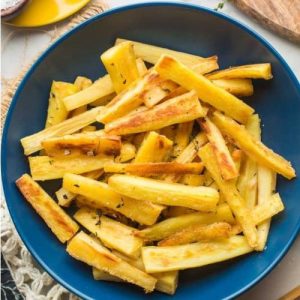
Honey Roast Parsnips
Sweet, tender, and lightly crisped, these Honey Roast Parsnips are an easy side dish that pairs perfectly with everyday dinners or holiday feasts. With just a handful of ingredients, they’re ready in about an hour and deliver a nutritious boost of fiber, natural sweetness, and heart-healthy fats.
Equipment
- 1 large pot
- 1 colander
- 1 roasting pan or baking sheet
- 1 Mixing Bowl
- 1 knife and cutting board
Ingredients
- 4 medium parsnips washed or peeled, ends trimmed
- 1 tablespoon gluten-free all-purpose flour
- 2 tablespoons olive oil or melted butter
- 1 tablespoon runny honey or maple syrup for vegan/low FODMAP
- 3 –4 sprigs fresh thyme
- ½ teaspoon salt plus more to taste
- Freshly ground black pepper optional, to serve
Instructions
- Prepare the Oven: Begin by preheating your oven to 425°F (220°C). A properly heated oven is essential for ensuring your parsnips develop that irresistible golden crust while remaining tender inside.Line your roasting pan or baking sheet with parchment paper if you prefer an easier cleanup.
- Clean and Cut the Parsnips: Wash the parsnips thoroughly under running water to remove any dirt. If the skin feels tough or blemished, peel them using a vegetable peeler. Trim off the ends, then cut each parsnip into uniform sticks — about 3 inches long and ¼ inch thick. Consistency in size helps them cook evenly, so avoid leaving very thick or very thin pieces.
- Parboil the Parsnips: Place the parsnip sticks into a large pot and cover them completely with cold water. Add about ½ teaspoon of salt to season them from the inside out. Bring the water to a boil over medium-high heat, then allow the parsnips to cook for 5 minutes. This short parboil softens the centers, helping the inside turn fluffy later while allowing the outside to crisp up beautifully in the oven.
- Steam-Dry for Extra Crispness: Once parboiled, carefully drain the hot water using a colander.To remove any excess surface moisture — which can prevent crisping — let the parsnips rest in the colander for 5 minutes. Place the colander over the warm pot so the residual steam helps dry them more efficiently. Drying is key to achieving that roasted, caramelized finish.
- Coat with Flour for Crunch: Return the parsnips to the now-empty pot or place them in a large mixing bowl. Sprinkle 1 tablespoon of gluten-free flour over the surface. Gently toss until all pieces are lightly dusted. The flour acts as a coating that encourages the exterior to crisp and brown more evenly during roasting.
- Prepare the Honey Glaze: In a small bowl, combine 2 tablespoons of olive oil (or melted butter) with 1 tablespoon of runny honey. Add a pinch of salt and whisk until the mixture blends into a smooth glaze. This mixture will provide a balance of sweetness and richness, giving your parsnips a glossy finish and a caramelized flavor.
- Combine Parsnips and Glaze: Pour the honey glaze over the floured parsnips. Add a few sprigs of fresh thyme, which will infuse a subtle herbal aroma as the parsnips roast. Gently toss everything together until each piece is well-coated. Make sure there are no dry patches — the glaze should cling evenly to the parsnip sticks.
- Arrange for Roasting: Spread the coated parsnips out on a roasting pan in a single layer. Avoid overcrowding — too many pieces stacked on top of each other will steam instead of crisp. If necessary, divide them between two pans to give each stick enough room to roast properly.
- Roast and Flip for Even Cooking: Place the pan in the preheated oven and roast for 20 minutes. At this stage, the bottoms will begin to caramelize. Using tongs or a spatula, flip each parsnip so the other side can brown as well. If you’re using two trays, swap their positions in the oven for even heat distribution. Continue roasting for an additional 20–25 minutes until the parsnips are fork-tender and golden at the edges.
- Final Seasoning and Serve: Once roasted, remove the pan from the oven. Taste and adjust the seasoning — add more salt if needed, or crack some fresh black pepper over the top for a hint of spice. Garnish with extra thyme leaves if desired. Serve your Honey Roast Parsnips warm as a wholesome side dish, perfect with roasts, grilled mains, or even on their own as a snack.
Notes
- For a vegan or low-FODMAP version, swap honey with maple syrup and use olive oil or dairy-free butter.
- Parboiling helps soften the centers, making the parsnips fluffier inside and crispier outside. Skipping this step may lead to chewier results.
- Don’t overcrowd the baking tray — space allows heat circulation, giving you crisp edges instead of soggy parsnips.
- Fresh thyme adds an earthy aroma, but rosemary or sage can be used for variety.
- Use parchment paper for easier cleanup and to prevent sticking.
- Adjust roasting time slightly if your parsnips are cut thicker or thinner than suggested.
- A light dusting of flour ensures crunch; use chickpea flour or rice flour if gluten-free.
- Leftovers can be repurposed in salads, wraps, or even blended into soups.
- For extra caramelization, drizzle a touch more honey in the last 5 minutes of roasting.
- Season generously at the end, as roasting tends to mellow the saltiness.